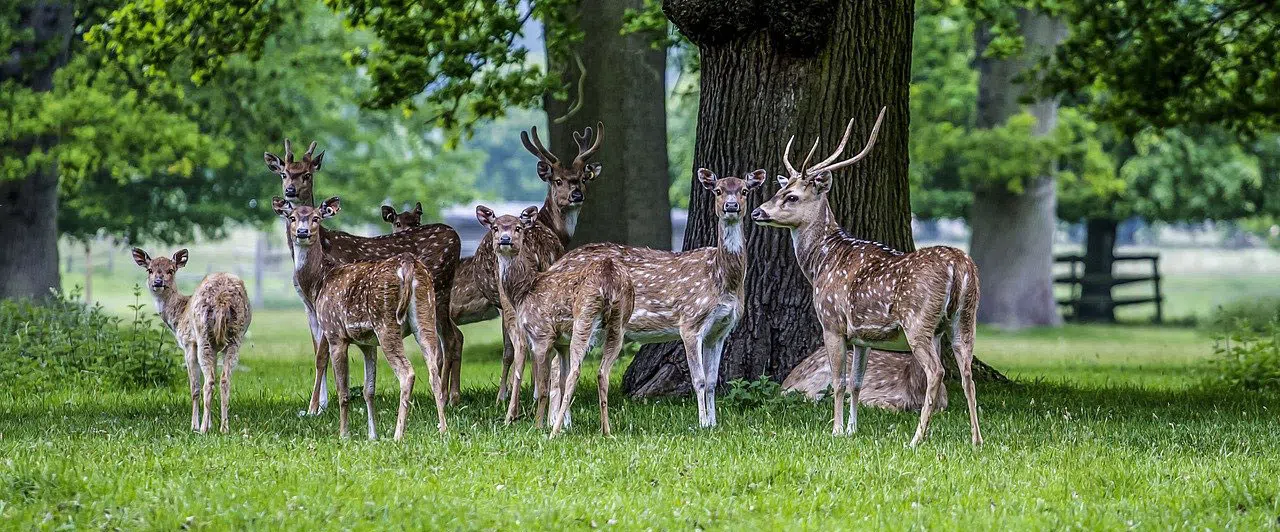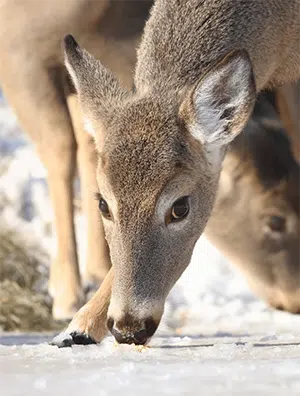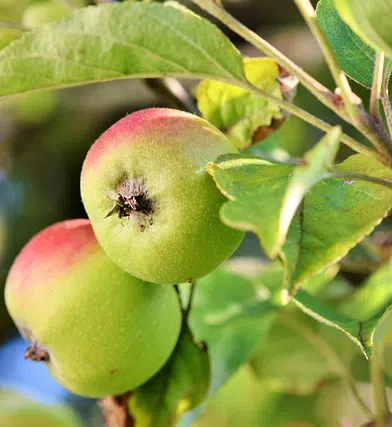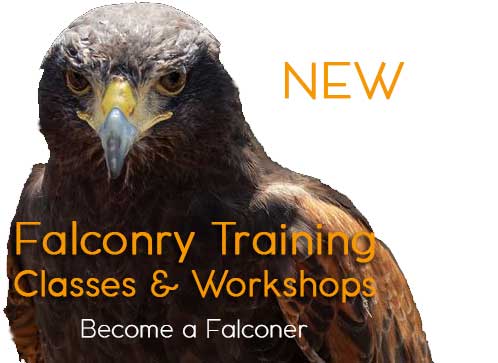Globally, there are approximately 40 members of the deer family (Cervidae) , although only five of those are found in Canada: white-tailed deer, mule deer, caribou, moose, and wapiti. Let's explore what wild deer like to eat:

What Do Deer Eat?: Deer Diet Basics
Deer are herbivores. They enjoy a quite well rounded diet, consisting of grasses, sedges, small shrubs, broad leaf plants, leaves and shoots of trees and other woody plants, and mushrooms. When in season, fruits and berries, as well as vegetables may make it onto the menu.
Types of Deer and Their Dietary Preferences
White Tailed Deer
This shy and elusive creature lives on leaves, fungi, lichens, mushrooms, alfalfa, twigs, nuts, and fruits. Highly ranked among what deer love to eat most are young vegetation and broad-leaf weeds, as they have trouble digesting mature plants.
Mule Deer
Native to the western regionns of the U.S. and Canada, Mule Deer eat a wide variety of vegetation, including fresh green leaves, lower branches of trees, twigs, and various types of grass.es. Additionally, they'll eat blackberries, raspberries, mistletoe, grapes, mushrooms, and ferns. They are even able to pick fruit of cacti.
Caribou
Caribou are nomads and continuously travel in search of food. In addition to small shrubs, sedges, lichens, and mushrooms, they'll also eat willow leaves and flowering tundra plants.
Moose
The majestic moose consumes all sorts of plants and all things green. Their diet includes spring blooms, grasses, vegetables, shrubs, and even aquatic plants.
Wapiti
Much like the other members within the Cervidae family, wapiti (also called American Elk) feed mostly on grasses, sedges, and forbs.
 Seasonal Variations in Deer Diet
Seasonal Variations in Deer Diet
All of our native deer populations prefer young, green and fresh shoots or blooms when available. During the winter months, of course, this isn't an option. In the winter time, they will gnaw on woody plants, shrubs, and even tree bark.
What do Baby Deer Eat?
Fawns get their nourishment exclusively from their mother's milk for the first few weeks of life. Usually born in late may - mid June, they will then be introduced to tender, young green shoots and eventually graduate to more woody plants over the course of summer. Proper digestion is paramount for their survival outside of maternal care.
Plant-Based Foods
Leaves and Twigs
The leaves and twigs of willows and nut trees are a favourite for many deer species. During the winter, they will also munch on dried leaves of all sorts of downed tree tops.
Grasses and Forbs
Grasses play a big role in deer diets. Deer are uniquely equipped to process cellulose found in grasses through fermentation in their four-chambered stomachs, allowing them to extract necessary nutrients. Forbs (flowering plants) like ragweed or pokeweed also provide much needed protein.
Fruits and Nuts
Many nuts are high in protein and carbohydrates. As long as a deer can crack the shell without too much effort, nuts are fair game. Chestnut trees seem to be one of the favourites. Fruits such as apples, pears, and a variety of berries (blueberry, raspberry, blackberry) are also staples in the deer diet.
 Agricultural Crops
Agricultural Crops
Various agricultural crops make it onto the dinner menu - much to a farmer's dismay. Deer seem to prefer oats over wheat, barley, or rye and this is likely due to the higher water and lower starch content in oats. With an average deer able to consume several pounds of plants a day, the damage to crop can be pretty devastating.
A Word to Gardeners
Deer prefer broad leaved plants and flowers with a mild scent.
What deer like to eat?
Your hostas, roses, azaleas, ivy, pansies, violas, sunflowers and tulips will all be devoured. Your edible garden may also get raided. Deer are quite fond of carrots, sweet corn, beets, cabbage, beans, lettuce, and broccoli. And, of course, your berries and fruit trees are fair game, too.
What do deer don't like to eat?
Some of the deer resistant plants for your flower garden include butterfly bush, verbena, snap dragon, boxwood and spirea. Also, deer detest strong scented plants like garlic, onions, tomatoes, rhubarb, asparagus, or peppermint - so maybe a bulb of garlic planted in between flowers may be helpful.
Less Common Food Sources
Fungi and Mushrooms
Mushrooms that are rich in phosphorus are especially important for male deer (bucks or bulls) for growing antlers. Mushrooms also have protein and vitamins that are not easily found elsewhere. Deer are even able to digest mushrooms that are mildly toxic to other animals (including humans!).
Bark and Tree Cambium
Tree bark becomes a necessary part of deer diet during the winter months, in particular. When no green shoots can be found, woody plants and tree bark or dried leaves will have to do.
Aquatic Plants
If you're a gardener with a lovely lily pond, you may not be overly fond of deer. Deer adore water lilies and will devour the blooms, buds, leaves, and even the stems. The same goes for water poppies and water hawthorn. On the other hand, water iris or water hyacinth seem to be deer resistant.
Feeding Behavior
Browsing vs. Grazing
Browsing and grazing refers to feeding habits common to herbivorous animals. When an animal is feeding on vegetation up high it is browsing. When it is feeing on low growing vegetation (like grasses) it is grazing. The majority of deer feeding is done browsing.
Daily Feeding Patterns
Every day, a deer needs to eat about 6 to 8 percent of its body weight in green foliage and browse to stay healthy. This is accomplished most commonly in the hours around dusk and dawn. While we may see deer out and about duirng the day, we'll likely notice them in a field grazing. The bulk of their food intake happens before dawn and after dusk. It is around this time, they will also come down to the water to drink.
Social Aspects of Deer Feeding
Deer evolved from solitary saltatorial animals (‘hiders’) to gregarious cursorial ones (‘runners’), now living in social or family groups. In some cases, these groups may be both social and familial. Since so much of their time is devoted to foraging and deer are prey animals, it makes sense to do so in groups. After all, there is strength in numbers!
Hawkeye: Your Humane Animal Control Specialists!
If you find your yard inundated with deer and your gardens raided, there are a few things you can do to encourage deer to move on. If you have a dog, he or she may be enough to drive them away. Also, remove water and food sources as best as possible and consider growing plants with strong smells (such as garlic or peppermint). Careful with the peppermint, though.. it can take over an entire plot in no time at all., And, if none of this yields the desired results, it may be time to call in the professionals. Hawkeye Bird & Animal Control to the rescue! Contact us today for deer removal and let's keep those deer out of your yard.














